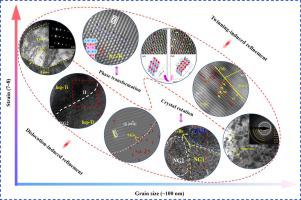当前位置:
X-MOL 学术
›
Appl. Surf. Sci.
›
论文详情
Our official English website, www.x-mol.net, welcomes your feedback! (Note: you will need to create a separate account there.)
Further refinement mechanisms of nanograins in nanocrystalline surface layer of TC17 subjected to severe plastic deformation
Applied Surface Science ( IF 6.7 ) Pub Date : 2021-02-01 , DOI: 10.1016/j.apsusc.2020.147941 C. Yang , M.Q. Li , Y.G. Liu
Applied Surface Science ( IF 6.7 ) Pub Date : 2021-02-01 , DOI: 10.1016/j.apsusc.2020.147941 C. Yang , M.Q. Li , Y.G. Liu

|
Abstract Further refinement mechanisms of nanograins in the surface layer of TC17 subjected to severe plastic deformation via high energy shot peening were investigated in detail by using the high-resolution transmission electron microscope. The abnormal face-centered cubic titanium (fcc-Ti) in nanoscale was observed in the surface layer of the HESP processed TC17. Specifically, the lattice constant of the fcc-Ti was of 0.356 nm, and the orientation relationship between the fcc-Ti and the hcp-Ti took as 011 > fcc | | 01 1 ¯ 1 > hcp and { 200 } fcc | | { 1 ¯ 011 } hcp , different from the typical orientation relationship. The two deformation mechanisms, i.e., deformation twinning and dislocation motions including statistically stored dislocations (SSDs) and geometrically necessary dislocations (GNDs), were both contributed to the further refinement of the nanograins. Due to the extremely high strain rate and stress level during HESP, the stacking faults in the abnormal fcc-Ti were characterized as extrinsic type, namely extrinsic stacking fault (ESF)/E-type stacking fault, which dominated the occurrence of twins. Different from the shear-induced twinning, the deformation twinning occurred in the abnormal nano fcc-Ti was induced by overlapping ESF ribbons, resulting in the further subdivision of nanograins.
中文翻译:

TC17纳米晶表面层严重塑性变形纳米颗粒的进一步细化机制
摘要 使用高分辨率透射电子显微镜详细研究了通过高能喷丸处理产生剧烈塑性变形的TC17表层纳米颗粒的进一步细化机制。在 HESP 处理的 TC17 的表面层中观察到纳米级的异常面心立方钛 (fcc-Ti)。具体而言,fcc-Ti 的晶格常数为 0.356 nm,fcc-Ti 和 hcp-Ti 的取向关系为 011 > fcc | | 01 1¯ 1 > hcp 和 { 200 } fcc | | { 1¯ 011 } hcp ,不同于典型的取向关系。两种变形机制,即变形孪生和位错运动,包括统计存储位错(SSD)和几何必要位错(GND),两者都有助于纳米颗粒的进一步细化。由于HESP过程中极高的应变率和应力水平,异常fcc-Ti中的堆垛层错被表征为外在类型,即外在堆垛层错(ESF)/E型堆垛层错,它主导了孪晶的发生。与剪切诱导孪生不同,异常纳米fcc-Ti中发生的变形孪生是由重叠的ESF带引起的,导致纳米晶粒的进一步细分。
更新日期:2021-02-01
中文翻译:

TC17纳米晶表面层严重塑性变形纳米颗粒的进一步细化机制
摘要 使用高分辨率透射电子显微镜详细研究了通过高能喷丸处理产生剧烈塑性变形的TC17表层纳米颗粒的进一步细化机制。在 HESP 处理的 TC17 的表面层中观察到纳米级的异常面心立方钛 (fcc-Ti)。具体而言,fcc-Ti 的晶格常数为 0.356 nm,fcc-Ti 和 hcp-Ti 的取向关系为 011 > fcc | | 01 1¯ 1 > hcp 和 { 200 } fcc | | { 1¯ 011 } hcp ,不同于典型的取向关系。两种变形机制,即变形孪生和位错运动,包括统计存储位错(SSD)和几何必要位错(GND),两者都有助于纳米颗粒的进一步细化。由于HESP过程中极高的应变率和应力水平,异常fcc-Ti中的堆垛层错被表征为外在类型,即外在堆垛层错(ESF)/E型堆垛层错,它主导了孪晶的发生。与剪切诱导孪生不同,异常纳米fcc-Ti中发生的变形孪生是由重叠的ESF带引起的,导致纳米晶粒的进一步细分。



























 京公网安备 11010802027423号
京公网安备 11010802027423号